| |
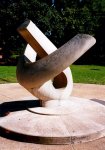 |
Chicago |
Illinois |
USA |
Equatorial Dial |
Dial 271 |
| ca 8' dia. Stone ca 7' high Two curved C shaped forms placed at perpendicular angles. |
| |
| |
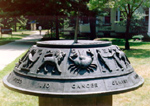 |
Cleveland |
Ohio |
USA |
Horizontal Dial |
Dial 270 |
| Horizontal dial 2 ft (0.6m) in diameter with a sloping circumference to increase the size of the to nearly 3 ft (1m). The sloping circumference is a flaring flange decorated with the 12 signs of the zodiac. Dial rests on an octagonal stone pillar.and base. |
| |
| |
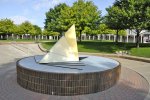 |
Warren |
Michigan |
USA |
Horizontal Dial |
Dial 269 |
| Horizontal dial 16 ft in diameter with 6 ft gnomon. The Sundial is pyramid shaped, painted in four different shades of yellow and white. Two sighting tubes along slanted upper edge. Sundial sits in center of circular concrete base with brick facing. |
| |
| |
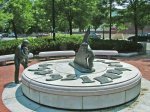 |
Charlestown |
Massachusetts |
USA |
Horizontal Dial |
Dial 268 |
| A 10 foot diameter bronze and granite horizontal dial with bronze gnomon and Arabic hour numerals on a 2 foot high granite base. Craftspeople of Colonial days are pictured on the face of the sundial. Sculptures depict a grandpa holding a baby while looking at the dial from the east side and a child peeking from behind the 5 foot tall bronze gnomon. Each bronze hour numeral includes a scene sculpture. |
| |
| |
|
Randolph City |
Vermont |
USA |
Armillary Sphere |
Dial 266 |
| 10 foot Cor-ten steel, concrete Entitled: Armillary VII. Contains an ecliptic ring, an equatorial ring and a gnomon ring. Engraved with the signs of the zodiac. |
| |
| |
|
Woodstock |
Vermont |
USA |
Analemmatic Dial |
Dial 265 |
| ca 18' ft Concrete blocks Composed of rectangular cement blocks set in a semi-circle with the hours of the day etched into the side of each block. Facing these is a cement walkway with the initials of each month of the year. |
| |
| |
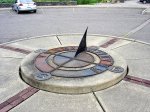 |
South Burlington |
Vermont |
USA |
Horizontal Dial |
Dial 264 |
| An 8 foot wrought iron steel horizontal dial. Design is of two circles enclosing one another and quartered. Outer circle is 11 foot wide with beaded edges and Roman hour numerals. Inner circle is 3'4" diameter quartered disk. Surveyed in 1992, finding condition very poor; steel dial is rusted. No motto or plaque is provided. |
| |
| |
|
Lawrence |
Kansas |
USA |
Horizontal Dial |
Dial 263 |
| 24x42x42' Concrete, stainless steel 17x2x21' The original limestone pointer and 'Eutin' flower were vandalized and replaced by stainless steel pointer and cast concrete flower. |
| |
| |
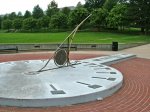 |
College Park |
Maryland |
USA |
Horizontal Dial |
Dial 260 |
| Very large horizontal dial 25 foot in diameter. Concrete dial with bronze gnomon 6' 6" high at tip. Has hour markers on raised circular slab. Metal disc with university seal in center of pierced gnomon. Adjacent graph provided correction for both EOT and mean/standard time differences. Due north or gnomon are shadow markers for date of year. Relocated May 1991 to present site. |
| |
| |
 |
Sunderland |
Maryland |
USA |
Horizontal Dial |
Dial 259 |
| A brass horizontal dial 11.5 inches in diameter with a 7 inch high gnomon. The dial is intricately engraved and includes compass points and gradations of the clock to two minutes. Made by "E. Nairne", a London dial maker in the 1750's to 1800. Rector Stephanie Chase Wilson says "I believe it was made specifically for our church as it has the name "All St.s Parish Calvt County" written on the face on the opposite side from "E. Nairne." The oral history of its origins is that it was commissioned by the Rev. Thomas Claggett, rector of All Saints from 1769-1777, and again from 1786-1792. He gave the sundial to the church in thanksgiving for being called as the first Bishop consecrated on American soil on September 17, 1792 in Trinity Church, New York."
"About 15-20 years ago the sundial was stolen from the church, but a quick-thinking parishioner got word out to every antique store within 100 miles and several days later it was recovered. A replica was created and now sits outside the church on a pedestal. The original is under lock and key. The only special care it gets is an occasional dusting. " |
| |
| |
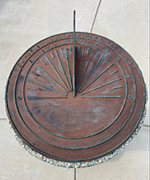 |
Bethesda |
Maryland |
USA |
Horizontal Dial |
Dial 258 |
| Farenholt sundial for U.S. Naval Center Maryland. This cast bronze dial was designed and commissioned by RADM Farenholt for U.S. Naval Hospitals at bases where he was commanding officer, visited, or had special meaning to him. The dial is 18 inches (46cm) in diameter. The outer chapter ring has the motto, followed by a chapter ring with Arabic hours 6am to 6pm, raised hour lines that radiate from near the foot of the gnomon and short half-hour lines. The gnomon has graceful curves and a trefoil cut-out in the center. The dial base is on a stone pillar. The dial sits in a shallow stone bowl about 3 feet from the ground. |
| |
| |
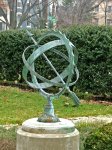 |
Washington |
District of Columbia |
USA |
Armillary Sphere |
Dial 257 |
| The bronze armillary sphere dial is unremarkable yet is oriented accurately and is complete. About 2 feet in diameter. Hour numerals are Roman and show 5 AM to 7PM. It commemorates a longtime gallery official. |
| |
| |
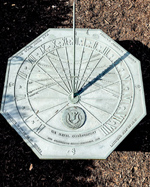 |
Washington |
District of Columbia |
USA |
Horizontal Dial |
Dial 256 |
| Octagonal bronze horizontal dial, mounted just above the ground level. Designed by Richard Schmidt of the USNO staff and cast by Alex Bigler of Equestrian Forge celebrates the 100th anniversary of the move of the USNO to its present site at Observatory Circle. The USNO was founded in 1830. Public, but by appointment only (202-762-1438). |
| |
| |
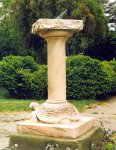 |
Leesburg |
Virginia |
USA |
Horizontal Dial |
Dial 255 |
| A small bronze horizontal dial 9.25 inches (23.5 cm) in diameter on an 18 x 18 inch (46 x 46 cm) block of marble. The pedestal of Tennessee marble rests on the back of a carved tortoise. The sides of the square block capital are deeply carved with oak leaves and acorns. When the dial was seen in 1998, the dial was not aligned to north. |
| |
| |
 |
Alexandria |
Virginia |
USA |
Horizontal Dial |
Dial 254 |
| A bronze horizontal dial on a hexagonal pedestal. Gnomon angle measures 31.9°, wrong for local latitude. Gnomon is aligned southwest rather than true north. Dial sits in a former fountain installed in 1896. |
| |
| |
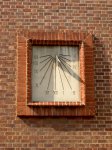 |
Alexandria |
Virginia |
USA |
Vertical Dial |
Dial 253 |
| A carved vertical dial approximately 46x41 inch, probably of sandstone, placed about 13 feet above street level. Dial face declines 22° W. |
| |
| |
|
New York |
New York |
USA |
Horizontal Dial |
Dial 252 |
| Sheet Metal Octagonal. Built by a prisoner. |
| |
| |
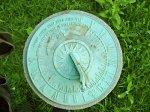 |
New York |
New York |
USA |
Horizontal Dial |
Dial 251 |
| An 11 inch diameter bronze horizontal dial on a 3 foot pedestal. Tip of gnomon is broken. |
| |
| |
 |
New York |
New York |
USA |
Globe or Hemispheric |
Dial 250 |
| Granite model of old roman hemicyclium dial with beautiful horizontal bronze gnomon with figure of woman. Hour and date lines may be incorrect. Slightly vandalized and chipped. This dial is a detail of a larger park bench that itself was designed to show time on the equinoxes; refer to Dial 614. The park bench alignment is nominally north but this dial may be misaligned as the Roman hour numbers inscribed on the face run clockwise, incorrect for a south-facing dial. Dial sits atop a large stone park bench. |
| |
| |
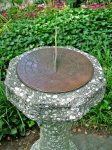 |
New York |
New York |
USA |
Horizontal Dial |
Dial 249 |
| A 10 inch diameter rough brass horizontal dial, painted brown, on a 3 foot cement pedestal. Gnomon is damaged. Roman hour numerals. Dial sits atop a cast stone pedestal about 3 feet high. |
| |
| |
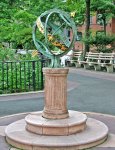 |
New York |
New York |
USA |
Armillary Sphere |
Dial 248 |
| The armillary dial is 30 inches in diameter, built of bronze with a cast stone pedestal. On the outside of equatorial band are golden zodiac signs. Inside the band are roman numerals for hours from 6 am to 6 pm. The dial was vandalized but was refurbished in 2000 and moved a short distance in Parks Dept. renovation. Sal Ton Landscape was the general contractor; Kenneth Lynch & Sons repaired the sundial and made a complete new cast stone fluded base in 2000. |
| |
| |
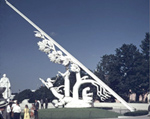 |
Queens |
New York |
USA |
Horizontal Dial |
Dial 247 |
| Paul Manship was commissioned to make the sundial for the 1939 World's Fair in New York. The dial was named "Time and the Fates of Man." Manship wrote, "The Perisphere and Trylon at the World's Fair suggests to me measurements of time and space, so my sundial… relates to the background of the central motif of the Fair." His white plaster sculpture was the biggest sundial in the world, standing 80 feet tall. |
| |
| |
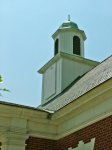 |
Queens |
New York |
USA |
Vertical Dial |
Dial 246 |
| A vertical dial on the cupola above the main entrance. Declination 70° 12' 04" E. Painted all white so that no hour lines can be seen. |
| |
| |
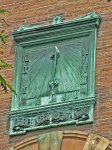 |
New York |
New York |
USA |
Vertical Dial |
Dial 245 |
| 3 x 4 feet bronze vertical declining S 28° W, 30 feet above the street level. |
| |
| |
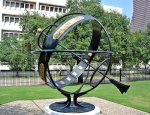 |
Houston |
Texas |
USA |
Armillary Sphere |
Dial 244 |
| A 72 inch painted steel armillary dial with meridian, equatorial, horizon, Arctic and Antarctic rings. Equatorial ring has hourly Roman numerals and zodiacal symbols on its exterior.
A bronze plaque on the base explains the armillary operation and provides a table of combined EOT and longitude corrections. Since Houston is more than 5 degrees from the time zone meridian, the longitude correction is almost 22 minutes, greater than the largest EOT correction, resulting in the combined corrections to always add to the dial time. Dial is mounted to a two foot diameter concrete pedestal.
This dial was restored in 2000 by the Houston Municipal Art Commission funded by Searcy and Elizabeth Bracewell. |
| |
| |
 |
Baltimore |
Maryland |
USA |
Vertical Dial |
Dial 243 |
| 18 x29 inch vertical dial. Solar noon analemma, equinox and solstice lines, horizontal lines, line showing approx shadow lengths on April 15 and Aug 31. Lines sandblasted into veined white Carrera marble. Dial is calibrated for EDT. AM hours indicated by shadow of stile's western edge, PM, by shadow of its eastern edge. When shadow tip is bisected by appropriate seasonal segment of the line of the analemma, it is 1:06:35 PM. |
| |
| |
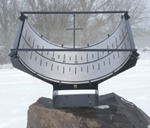 |
Goldendale |
Washington |
USA |
Cylindrical Dial |
Dial 242 |
| The sundial has a 53-inch semicircular steel equatorial ring and is 18-inches wide. The 18-inch rod gnomon is suspended above the dial by two horizontal rods. A small cross-bar in the middle of the gnomon acts as a nodus for telling the date. A mechanical adjustment allows for the equation of time correction. The dial is mounted on a large boulder on the Northwest end of the Goldendale Observatory close to the Solar Telescope Building. |
| |
| |
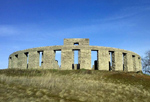 |
Maryhill |
Washington |
USA |
Sun Alignment |
Dial 241 |
| The Maryhill Stonehenge was the first monument in the US to honor the dead of World War I. It is 180-feet across with pillars of reinforced concrete, duplicating, as nearly as possible the original size and design of Stonehenge. The outer circle has thirty 16-foot pillars while the inner circle has forty pillars 9-foot high. Build by a wealthy entrepreneur Sam Hill as a memorial to servicemen of Klickitat County. |
| |
| |
 |
Penticton |
British Columbia |
Canada |
Analemmatic Dial |
Dial 240 |
| This analemmatic dial, the "Skaha Solar Timepiece", dates from 1984 and spans an area of 65' x 35'. At the center is a platform marked out with a steel analemma, acting as the date scale. The steel is embossed with a date scale and zodiac. The hour and cardinal direction markers are concrete posts, installed in 1998 to replace the rotted originals. The size and positioning of the analemma is somewhat mismatched to the placement of concrete markers, but overall it is a well-made piece in a pleasant setting. A nearby explanatory plaque claims, incorrectly, that this is the third-ever analemmatic sundial in the world. |
| |
| |
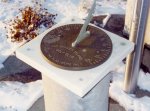 |
Cohoes |
New York |
USA |
Horizontal Dial |
Dial 239 |
| 12' Bronze 10' Metal dial mounted on marble(?) square atop column. Roman numerals 5AM-7PM. 'Van Schaick Island Golf Club' on dial face above inscription. 'In memory of/ John F. Gaucas/ Who Served as Golf Professional at the/ Van Schaick Island Country Club/ 1944 to 1974' on small granite marker near base of dial. |
| |
| |
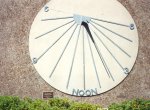 |
Rocklin |
California |
USA |
Vertical Dial |
Dial 238 |
| Small, circular 12.5 in. vertical dial mounted 56 in. above ground on the south wall of the library. Dial is aluminum mounted on concrete. Hour line missing from 6AM to gnomon base. Wall faces 26 degrees SW. Hour lines, numbered only at 6, 9, 12, 3 and 6. Two memorial plaques adjacent to dial. One reads 'Sierra College Honors/ E. R. 'Russ' Fallon/ for Dedicated Services/ Building Inspector/ Building and Grounds Supervisor/ 1959-1975'. Other reads 'In Admiration and Fond Memory/ of Our Colleague/ Dwight Hall/ 1927-1972/ by the/ Academic Senate and Friends/ at Sierra College.' |
| |
| |
 |
New Orleans |
Louisiana |
USA |
Horizontal Dial |
Dial 237 |
| This large horizontal sundial sits on a slightly pink concrete egg-shaped base 24 x 17.5 feet. This dais is nearly at ground level. The gnomon is an elegant stainless steel blade approximately 8 feet high sitting at the widest part of the dais, with hours marked around the dais edge with small bronze animals at each hour from 6am to 6pm. For example the noon hour is represented by a turtle. |
| |
| |
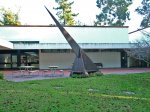 |
Oakland |
California |
USA |
Horizontal Dial |
Dial 236 |
| Large horizontal dial, with steel gnomon 26 ft. (8m) long, 16 ft. (5m) high, and 6 ft. (2m) wide. It looks like a sculpture of three interlocking triangles. The triangles of 2-inch thick Cor-Ten steel plates create the dial's gnomon and supporting structure. Overall, the sundial weighs about 5,700 pounds. The dial sits in a courtyard where the only hour markers are placed on the lawn and brick patio around the dial. EOT values for every 5 days are shown on the north face of the support. |
| |
| |
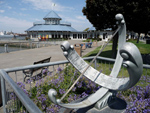 |
Vallejo |
California |
USA |
Equatorial Dial |
Dial 235 |
| A 5-foot equatorial sundial with elegant time and meridian supporting arcs. The gnomon A 5 ft. aluminum polar dial. The gnomon has the profile of the Golden Gate Bridge. Time is marked in both standard and daylight saving time with Roman numerals. The dial was a gift from Vallejo's Sister city, Akashi, Japan. |
| |
| |
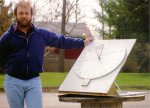 |
Louisville |
Kentucky |
USA |
Equatorial Dial |
Dial 234 |
| Park rangers set up a 16 x 20 inch portable equatorial sundial. The dial is used for teaching a solar energy class. |
| |
| |
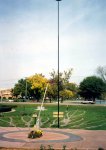 |
Pekin |
Illinois |
USA |
Horizontal Dial |
Dial 233 |
| Two sundials. One is a horizontal sundial 6-ft. tall with a sloping 15-ft bright aluminum gnomon. The dial is called "Sundance". Adjacent is a gnomonic sundial with a 45-ft pole projecting its shadow onto the lawn in front of it. The ground level dial face consists of seven analemmas drawn in the grass field that surrounds the dial center. The analemmas are drawn for the hours 8 am to 3 pm. However, the noon analemma is larger and corresponds to the shadow of a disk atop the vertical pole. |
| |
| |
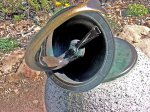 |
Santa Barbara |
California |
USA |
Equatorial Dial |
Dial 232 |
| A small bronze equatorial dial made by Victor E. Edwards in the 1920's. It has an unusual crescent shaped arm with notch at the upper end. The arm is rotated until sunlight through the notch strikes an analemma on the lower inner curve of the crescent. Time is then read on a circular dial from an "hour hand" pointer extending from the base of the crescent. The dial is mounted on a granite pedestal with spherical top 21 inch high. |
| |
| |
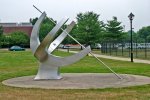 |
Ewing |
New Jersey |
USA |
Compound Dial |
Dial 231 |
| A combination horizontal and equatorial dial. Stainless steel equatorial ring is 8 feet wide x 10 feet high. Equatorial gnomon extends to cement face of horizontal dial. Bronze plaque provides a table of corrections for EOT and longitude. Identified as the William H. Hausdoerffer Sundial to honor Dr. Hausdoerffer, Class of 1936, Professor Emeritus of Mathematics, Department Chairman, Dean of Men, TSC Athletic Hall of Fame, Alumni Executive Board and adviser to many groups, serving from 1940 to 1979. |
| |
| |
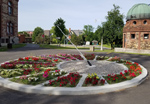 |
Ottawa |
Ontario |
Canada |
Horizontal Dial |
Dial 230 |
| A large horizontal floral dial approximately 20 feet in diameter. Large circular area on ground forming the dial face with gravel and flower-beds between the hour lines. The flowers are annuals, best seen in the summer blooming season. Update June 2018: The dial has been refurbished with a new, accurately placed gnomon and wonderful bright flowers. |
| |
| |
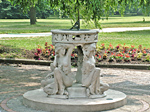 |
Philadelphia |
Pennsylvania |
USA |
Horizontal Dial |
Dial 229 |
| Bronze horizontal dial by Alexander Stirling Calder. Local Hour lines plus EoT monthly corrections and differences between 12 world cities. Tip of gnomon appears damaged. The elegant pedestal sculpture is made of white marble and depicts 4 seated young women as the four seasons holding the dial plinth on their shoulders. The plinth itself is intricately carved with the animals of the zodiac. Height 42-inches, Diameter 50-inches. The dial was a gift of Mrs. Charles P. Turner, through the Fairmount Park Art Association (now the Association for Public Art) to the City of Philadelphia |
| |
| |
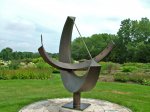 |
Chicago |
Illinois |
USA |
Equatorial Dial |
Dial 228 |
| Equatorial in bronze. 2 meters in diameter. Arabic hour numerals. Hour scale is subdivided into 5 minute intervals. |
| |
| |
 |
Silver Bay |
Minnesota |
USA |
Horizontal Dial |
Dial 227 |
| A horizontal dial on the ground, with an hour circle about 12 feet. The gnomon is of steel, about 4 foot high. The gnomon is oriented to magnetic north. It is not an accurate device. Three boulders surround the dial and cut off the shadow much of the time. Gravel hour circle has rocks to mark the hours, but the rocks can be moved and are strewn all about. More suggestive of a dial than a real dial. |
| |
| |
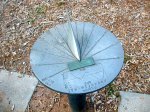 |
Macon |
Georgia |
USA |
Horizontal Dial |
Dial 226 |
| A horizontal dial 16 inches in diameter located beside the observatory, just outside the museum. Includes hour markings for EST and DST and an EOT graph. Hour lines corrected for longitude. Mounted on a 24 inch high pedestal low enough for children to enjoy. |
| |
| |
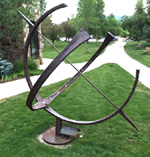 |
Steamboat Springs |
Colorado |
USA |
Equatorial Dial |
Dial 225 |
| This equatorial sundial is a memorial to Barbara Perry Cosel and sits in front of the"Bud" Werner library. A large 6 ft. thin iron equatorial, it is constructed of two 270 degree arcs that intersect at right angles. Time marks are simple detente marks on the equatorial arc. The gnomon is a traditional arrow. At the base of the dial is a plaque containing a graph of the Equation of Time to determine Mountain Standard Time. |
| |
| |
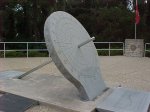 |
St. Petersburg |
Florida |
USA |
Equatorial Dial |
Dial 224 |
| An equatorial dial built by Erickson Monument Co in 1974 for the War Veterans Memorial Park. Dial is 6 feet in diameter made from granite. The gnomon rod of about 3 inches diameter is stainless steel. Hour, half hours, quarter hours and five minute marks show the time. For symmetry, the face has hours marked for the entire 24 hours, though in Florida the excursion of time from 6am to 6pm is relatively small. The hour lines are rotated for the site longitude. |
| |
| |
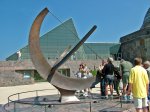 |
Chicago |
Illinois |
USA |
Equatorial Dial |
Dial 223 |
| Henry Moore Sundial Sculpture: 13 foot bronze equatorial dial built in 1980. Two bronze semicircles, one set inside and at right angles to the other, form the main elements. A slim rod runs from one end of the outer semicircle to the other end and its shadow on the inner semicircle below marks the time of day. EOT correction is provided. |
| |
| |
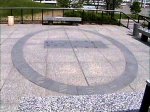 |
Colorado Springs |
Colorado |
USA |
Analemmatic Dial |
Dial 222 |
| Analemmatic dial in granite and bronze. 9ft x 12ft. Mottled granite block surface with number border of smooth granite blocks. Hour numbers are engraved in granite. Zodiac marker is brass, embedded in the granite face. As with most analemmatics, the dial is not corrected for longitude. Fortunately, the location is very close to the center of the time zone at 105 deg W. User stands on a central analemma at correct date and acts as the gnomon to cast a shadow that points to local solar time. The aspect ratio is not correct for the latitude and the positions of the solstice markers are slightly off. |
| |
| |
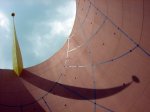 |
Lake Buena Vista |
Florida |
USA |
Gnomonic or Projection Dial |
Dial 221 |
| Conical dial 120 ft. high, 122 ft. diameter at base and has an 85 ft circular opening to the sky. In the middle of the opening is a spherical nodus that casts its shadow into the concrete structure. According to the Guinness Book of Records in 1995, this is the world's largest sundial. Designed by Isozaki and calculated by Ross McCluney, the sundial is a large truncated, slanted cone, with hour markings on the inside. McCluney was NASS's first president. |
| |
| |
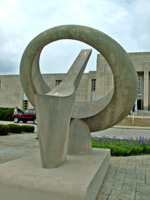 |
Indianapolis |
Indiana |
USA |
Equatorial Dial |
Dial 220 |
| A five foot diameter donut-shaped full circle equatorial pierced by equally massive Indiana Limestone shaft as gnomon. Hour numerals are Arabic. Subdivided into 15 minute increments. Equation of Time is given in the plaque at base |
| |
| |
 |
Oberlin |
Ohio |
USA |
Vertical Dial |
Dial 219 |
| Once, high on the physics building south wall was a student made vertical dial. The 5'x8.5' resin coated particle board made by Mark Kearns in 1979 had curved hour lines to account for the equation of time, declination of wall, and offset from standard meridian. This dial has not been on display for some time. Perhaps some student would create a new dial. The brick wall is an excellent location. |
| |